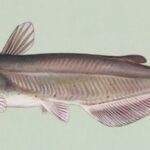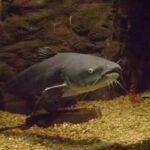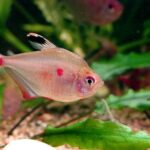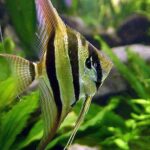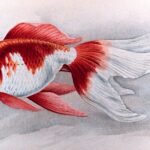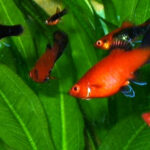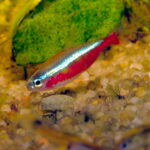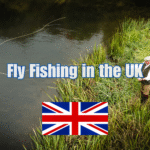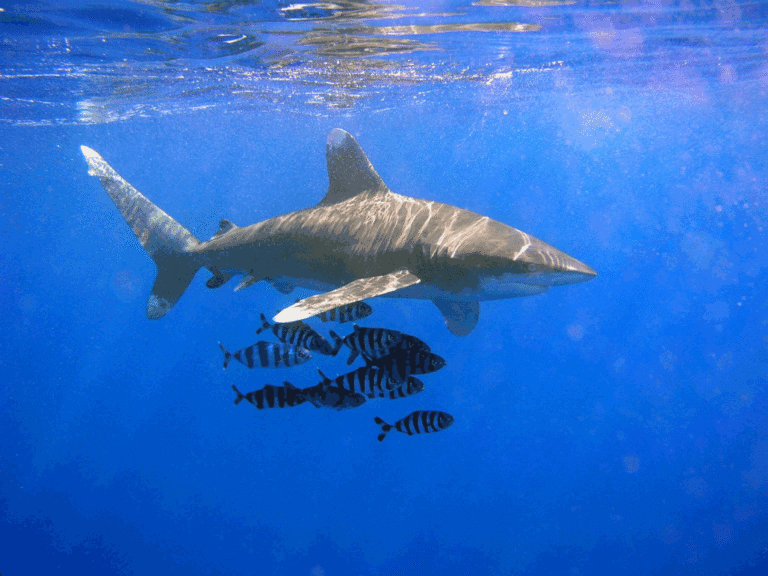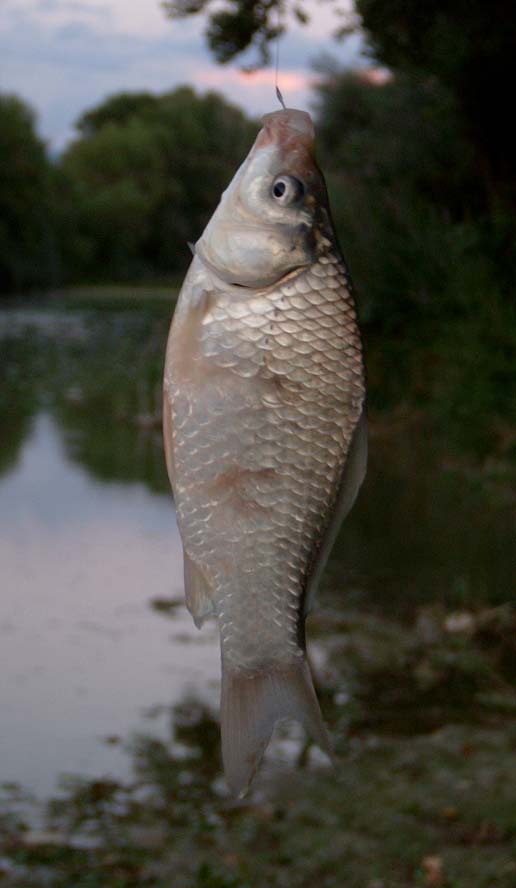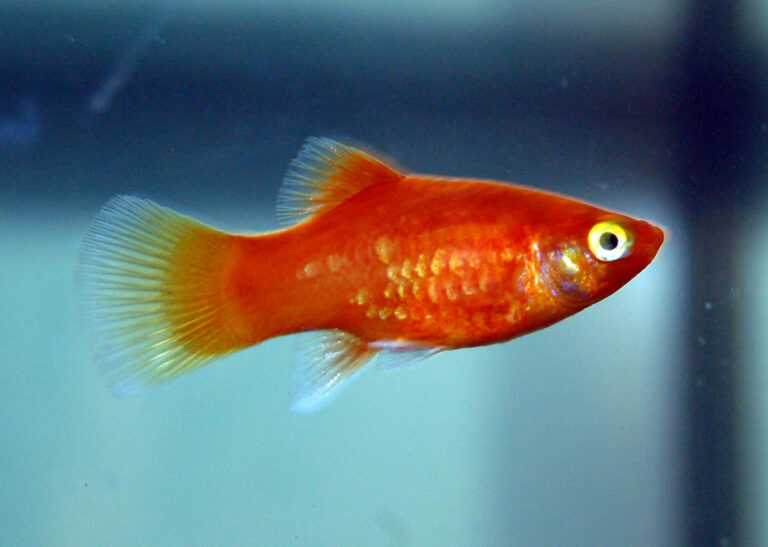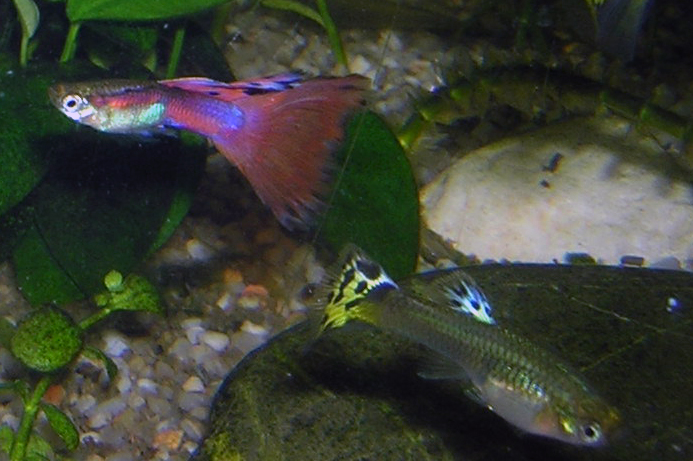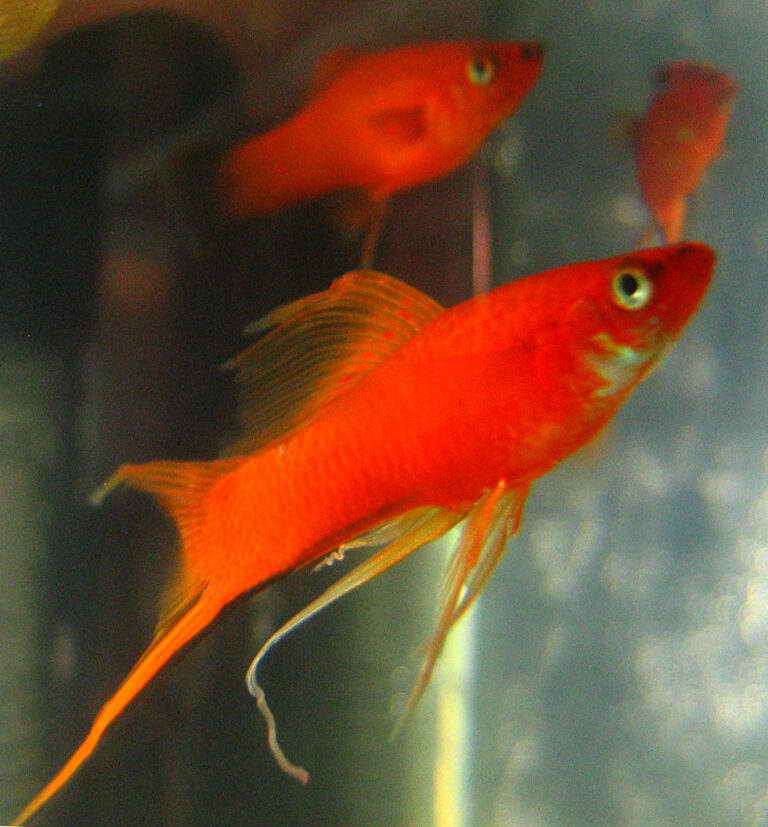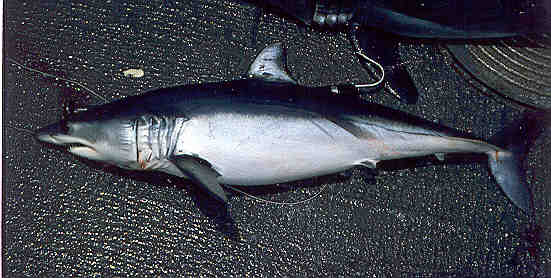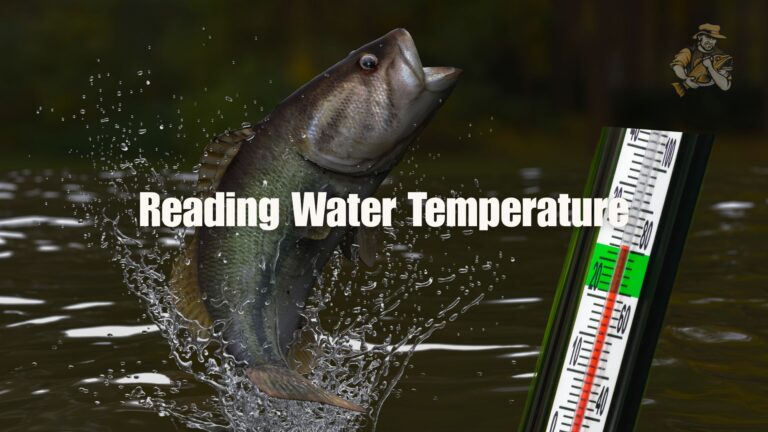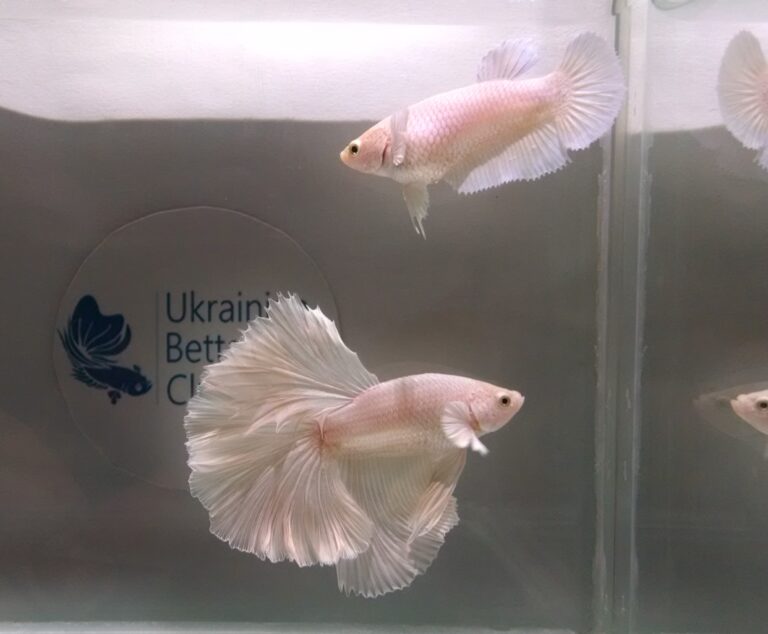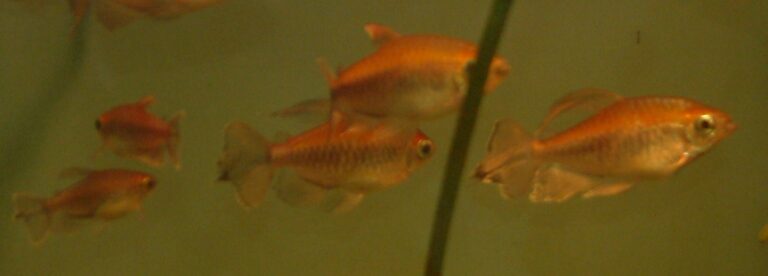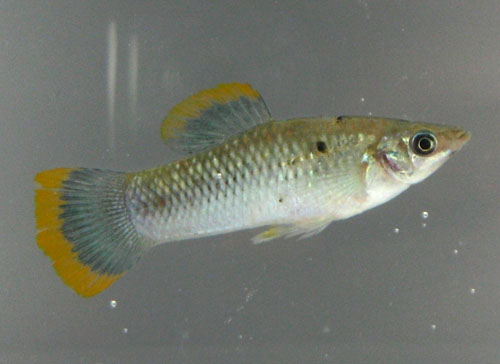Diamond Tetra
By Ryan Maron | Last Modified: June 7, 2025

The Diamond Tetra (Moenkhausia pittieri) stands as one of the most captivating freshwater fish species in the aquarium trade and its native South American ecosystems. This small but brilliantly reflective characin derives its common name from the diamond-like scales that shimmer across its silvery body, creating an almost metallic appearance under proper lighting conditions. Native to the coastal river systems of Venezuela and extending into parts of Colombia, the Diamond Tetra plays a crucial ecological role as both a micro-predator of invertebrates and a vital food source for larger piscivorous species within its freshwater habitat.
Within the complex food webs of South American river systems, Diamond Tetras function as essential intermediate predators, helping to control populations of small invertebrates while simultaneously supporting larger fish, birds, and aquatic mammals. Their schooling behavior and reproductive patterns contribute significantly to nutrient cycling in tropical freshwater ecosystems, making them far more than merely attractive aquarium specimens. The species has also gained considerable economic importance in the ornamental fish industry, with millions of specimens traded annually across global markets.
| Feature | Details |
| Common Name | Diamond Tetra |
| Scientific Name | Moenkhausia pittieri |
| Family | Characidae |
| Typical Size | 5-6 cm (2-2.4 inches), 3-5 grams |
| Habitat | Tropical freshwater rivers and tributaries |
| Diet | Omnivorous – insects, larvae, plant matter |
| Distribution | Northern South America (Venezuela, Colombia) |
| Conservation Status | Least Concern |
Taxonomy & Classification
The Diamond Tetra belongs to the extensive family Characidae, which encompasses over 1,100 species of freshwater fish distributed primarily throughout South America and Africa. First scientifically described by Eigenmann in 1920, Moenkhausia pittieri was named in honor of Swiss botanist Henri Pittier, who conducted extensive research in Venezuelan ecosystems during the early 20th century. The genus Moenkhausia currently includes approximately 88 recognized species, making it one of the more diverse genera within the characin family.
Phylogenetic studies have placed the Diamond Tetra within the subfamily Characinae, alongside other popular aquarium species such as various tetra species and related South American characins. The species exhibits typical characid features including a lateral line system, an adipose fin, and pharyngeal teeth adapted for processing both plant and animal matter. Recent molecular analyses suggest that M. pittieri diverged from its closest relatives approximately 15-20 million years ago during the Miocene epoch, coinciding with major geological changes in northern South America.
The taxonomic position of Diamond Tetras reflects their evolutionary relationship to other schooling characins, with genetic markers indicating close phylogenetic ties to species like Moenkhausia sanctaefilomenae and Moenkhausia oligolepis. This classification system helps scientists understand the evolutionary pressures that shaped the Diamond Tetra’s distinctive morphological and behavioral characteristics, particularly their highly reflective scales and complex social behaviors.
Physical Description
Diamond Tetras possess a laterally compressed, rhomboid body shape characteristic of mid-water schooling fish, with adult specimens typically reaching 5-6 centimeters in total length. The species’ most distinctive feature consists of highly reflective scales that create an iridescent, diamond-like appearance when light strikes the fish at various angles. Each scale contains specialized cells called iridophores, which contain reflective crystals of guanine that produce the characteristic metallic sheen ranging from silver to blue-green depending on lighting conditions and viewing angle.
The body coloration exhibits a base silver tone with a subtle lavender or purple hue along the dorsal region, transitioning to a brighter silver-white on the ventral surface. A distinctive dark humeral spot appears behind the gill cover, while a second, less prominent spot may be visible at the base of the caudal fin. The fins themselves display a translucent quality with subtle yellow or orange tinting, particularly noticeable in the anal and pelvic fins of mature specimens.
Sexual dimorphism becomes apparent in adult Diamond Tetras, with males typically displaying more intense coloration and slightly more elongated dorsal and anal fins. Mature females tend to exhibit a fuller, more rounded body profile, particularly evident during spawning periods when they carry developing eggs. The species possesses the characteristic adipose fin of characins, positioned between the dorsal and caudal fins, which likely serves sensory functions during schooling behavior and navigation.
The mouth structure reflects the species’ omnivorous feeding habits, featuring small, pointed teeth capable of processing both plant material and small invertebrates. Diamond Tetras possess well-developed eyes relative to their body size, an adaptation for their active diurnal lifestyle and the need to maintain visual contact with schooling companions in their natural riverine environments.
Habitat & Distribution
Diamond Tetras inhabit the coastal river systems of northern South America, with their primary distribution centered in Venezuela’s Caribbean coastal drainages and extending into adjacent areas of Colombia. These fish occupy slow to moderate-flowing sections of rivers and their tributaries, typically at elevations ranging from sea level to approximately 500 meters above sea level. The species shows a strong preference for areas with soft, slightly acidic water conditions, with pH levels typically ranging from 6.0 to 7.0 and temperatures between 24-28°C (75-82°F).
The natural habitat of Diamond Tetras consists of heavily vegetated river sections with abundant overhanging vegetation, submerged logs, and complex underwater root systems that provide both shelter and feeding opportunities. These environments typically feature moderate water flow rates that create well-oxygenated conditions while maintaining the clarity necessary for the visual communication essential to schooling behavior. The substrate in their preferred habitats usually consists of sand mixed with organic detritus, supporting diverse communities of invertebrates that serve as important food sources.
Water chemistry in Diamond Tetra habitats reflects the influence of tropical rainfall patterns and geological characteristics of the northern South American coastal plain. Total dissolved solids typically remain relatively low, ranging from 50-150 ppm, while dissolved oxygen levels remain consistently high due to water movement and photosynthetic activity from aquatic vegetation. The species demonstrates remarkable adaptability to seasonal variations in water level and flow rate, adjusting their behavioral patterns and habitat utilization accordingly.
These riverine ecosystems support diverse fish communities, with Diamond Tetras coexisting alongside numerous other characin species, small cichlids, catfish, and various invertebrate species. The complex habitat structure provides multiple ecological niches, allowing Diamond Tetras to exploit specific feeding and breeding opportunities while avoiding competition with larger or more specialized species sharing the same waterways.
Diet & Feeding Behavior
Diamond Tetras exhibit omnivorous feeding behavior, consuming a diverse array of food items that includes small invertebrates, plant matter, algae, and organic detritus. Their natural diet consists primarily of aquatic insect larvae, small crustaceans, microscopic worms, and various forms of phytoplankton and periphyton. During certain seasons, particularly when terrestrial insects are abundant, Diamond Tetras actively feed on flying insects that fall onto the water surface, demonstrating opportunistic feeding strategies that maximize energy intake.
The species employs several distinct foraging techniques depending on prey type and availability. When feeding on small invertebrates hiding among plant material, Diamond Tetras use precise picking motions to extract individual prey items without disturbing surrounding vegetation. For surface feeding, they exhibit rapid darting movements to capture fallen insects before these food items drift away or are consumed by competitors. Their pharyngeal teeth enable efficient processing of both soft plant tissues and the harder exoskeletons of small arthropods.
Schooling behavior significantly influences Diamond Tetra feeding patterns, with groups coordinating their foraging activities to maximize feeding efficiency while maintaining vigilance against predators. Individual fish within a school often specialize in different feeding techniques, with some focusing on benthic invertebrates while others concentrate on mid-water prey items. This behavioral flexibility allows schools to exploit multiple food sources simultaneously while reducing intraspecific competition.
Seasonal variations in food availability strongly influence Diamond Tetra feeding behavior and body condition. During high-water periods when terrestrial areas flood, these fish gain access to additional invertebrate communities and plant material, leading to rapid growth and improved reproductive condition. Similar feeding strategies are observed in other small characins, highlighting the evolutionary success of this generalist approach in dynamic tropical river environments.
Behavior & Adaptations
Diamond Tetras display highly developed schooling behavior, typically forming groups ranging from 20 to several hundred individuals depending on local population density and environmental conditions. These schools exhibit sophisticated coordination mechanisms, with individual fish maintaining precise spacing and synchronized swimming patterns that enhance both feeding efficiency and predator avoidance. The reflective properties of their scales serve dual functions, creating visual confusion for predators while simultaneously facilitating communication between school members through subtle changes in body positioning and light reflection.
The species demonstrates distinct diurnal activity patterns, with peak feeding and social interactions occurring during morning and late afternoon periods when light conditions optimize their visual communication systems. During midday hours, Diamond Tetra schools often seek shelter among vegetation or in shaded areas, reducing their visibility to aerial predators while conserving energy for more intensive feeding periods. This behavioral pattern aligns with the activity cycles of many of their invertebrate prey species.
Territorial behavior becomes evident during breeding periods, when mature males establish and defend small spawning territories among aquatic vegetation. These territories typically encompass areas of 0.5-1.0 square meters and are selected based on substrate quality, water flow characteristics, and proximity to suitable spawning sites. Males employ both visual displays and aggressive interactions to maintain territorial boundaries, with dominant individuals securing the most favorable locations for successful reproduction.
Diamond Tetras possess remarkable sensory adaptations that support their complex social behaviors and environmental awareness. Their lateral line system enables detection of subtle water movements created by both predators and prey, while their well-developed vision allows recognition of individual school members and assessment of environmental threats. The species also demonstrates learned behavioral responses, with experienced individuals serving as leaders within schools and guiding group movements toward favorable feeding or shelter areas.
Reproduction & Life Cycle
Diamond Tetras reach sexual maturity at approximately 8-12 months of age, with reproductive capability closely tied to both individual size and environmental conditions. The species exhibits seasonal breeding patterns that typically coincide with periods of increased food availability and optimal water conditions, usually during the beginning of the rainy season when water levels rise and new feeding areas become accessible. Mature females can be distinguished by their fuller body profile and slightly larger size compared to males, while breeding males develop more intense coloration and extended fin rays.
Spawning behavior begins with elaborate courtship displays, during which males establish territories in areas with fine-leaved vegetation or other suitable spawning substrates. Courtship involves complex swimming patterns where males circle females while displaying their most vibrant coloration and performing rapid fin movements designed to attract potential mates. The actual spawning process involves the female releasing 200-400 adhesive eggs over selected vegetation, which the male immediately fertilizes through synchronized release of milt.
The adhesive eggs attach firmly to plant material and require approximately 24-36 hours to hatch under optimal temperature conditions of 26-28°C. Newly hatched larvae remain attached to the spawning substrate for an additional 3-4 days while absorbing their yolk sacs, after which they become free-swimming fry capable of independent feeding. During this critical early period, survival rates depend heavily on water quality, temperature stability, and the absence of predators in the spawning area.
Juvenile Diamond Tetras initially feed on microscopic organisms including infusoria, small rotifers, and newly hatched brine shrimp nauplii. Growth rates vary significantly based on food availability and water temperature, with well-fed juveniles reaching 2-3 centimeters in length within their first three months. Young fish begin displaying schooling behavior at approximately 1.5 centimeters in length, initially forming small groups that gradually merge with larger adult schools as they mature and develop the full complement of behavioral and communication skills necessary for complex social interactions.
Predators & Threats
Diamond Tetras face predation pressure from numerous species throughout their life cycle, with different predators targeting various life stages from eggs to adult fish. Larger piscivorous fish such as cichlids, catfish, and characins represent the primary predation threat to adult Diamond Tetras, particularly during feeding periods when schools may disperse or venture into more exposed areas. Aerial predators including herons, kingfishers, and other fish-eating birds pose significant threats, especially in shallow areas where Diamond Tetra schools feed near the surface.
Aquatic invertebrate predators such as dragonfly nymphs, water beetles, and large crustaceans primarily target juvenile Diamond Tetras and may also consume eggs during spawning periods. The species’ reflective scales and schooling behavior serve as primary anti-predator adaptations, creating visual confusion through coordinated movement patterns and making it difficult for predators to focus on individual targets within the school. When threatened, Diamond Tetra schools exhibit rapid directional changes and may split into smaller groups that reconvene once the threat passes.
Environmental threats to Diamond Tetra populations include habitat degradation from agricultural runoff, deforestation, and urban development within their watershed areas. Changes in water chemistry, particularly increases in nutrient loading and sedimentation, can significantly impact their reproductive success and overall population health. Climate change effects, including altered rainfall patterns and temperature fluctuations, may disrupt breeding cycles and modify the availability of preferred habitat conditions.
The aquarium trade, while providing economic benefits to some regions, can create localized pressure on wild Diamond Tetra populations through overcollection. However, most specimens in the international trade are now produced through captive breeding programs, reducing pressure on wild populations. Invasive species introductions in some parts of their range may create additional competitive pressure or introduce novel predators that Diamond Tetras have not evolved defenses against.
Conservation Status
The International Union for Conservation of Nature (IUCN) currently classifies the Diamond Tetra as a species of Least Concern, reflecting its relatively stable population status and wide distribution within its native range. This classification is supported by the species’ adaptability to various habitat conditions, successful reproduction rates, and the absence of major threats that would significantly impact overall population viability. However, localized population declines have been documented in areas experiencing significant habitat modification or water quality degradation.
Regional conservation efforts focus primarily on watershed protection and habitat restoration within the Diamond Tetra’s native range in Venezuela and Colombia. These initiatives emphasize maintaining water quality standards, preserving riparian vegetation, and controlling agricultural and industrial pollution sources that could negatively impact freshwater ecosystems. Several protected areas within the species’ distribution provide important habitat refugia, ensuring the persistence of stable breeding populations.
The success of captive breeding programs has reduced pressure on wild Diamond Tetra populations while supporting the sustainable development of the ornamental fish industry. Commercial breeding facilities now produce the majority of specimens entering international markets, with established breeding protocols ensuring consistent genetic diversity and fish health. These programs also serve as genetic repositories that could support reintroduction efforts if localized extinctions occur.
Ongoing monitoring programs track Diamond Tetra population trends through standardized sampling protocols conducted in collaboration with regional universities and conservation organizations. These efforts provide essential data for adaptive management strategies and early detection of population declines that might require more intensive conservation interventions. Climate change monitoring components assess potential impacts on habitat suitability and reproductive success under projected environmental scenarios.
Human Interaction
Diamond Tetras have achieved significant prominence in the global aquarium trade, ranking among the most popular freshwater species for both novice and experienced aquarists. Their peaceful temperament, striking appearance, and relatively straightforward care requirements make them ideal community fish for tropical freshwater aquariums. The species adapts well to captive conditions, thriving in well-maintained aquarium systems that replicate their natural habitat preferences through appropriate water chemistry, temperature control, and aquascaping with live plants.
Commercial breeding operations have developed sophisticated techniques for Diamond Tetra reproduction, enabling large-scale production to meet international market demand. These facilities typically employ controlled environmental conditions including precise temperature regulation, water chemistry management, and optimized feeding protocols to maximize breeding success and fry survival rates. The economic impact of Diamond Tetra aquaculture extends beyond direct sales, supporting related industries including equipment manufacturing, feed production, and transportation services.
In their native range, Diamond Tetras play important cultural and economic roles within local communities. Artisanal fishermen occasionally harvest these fish for local markets, though they represent a minor component compared to larger food fish species. Some indigenous communities have traditional ecological knowledge regarding Diamond Tetra behavior and habitat preferences that has proven valuable for conservation planning and sustainable management practices.
Educational institutions frequently utilize Diamond Tetras in research projects focused on fish behavior, ecology, and conservation biology. Their well-documented natural history, combined with successful maintenance in laboratory conditions, makes them excellent model organisms for studies examining schooling behavior, predator-prey relationships, and reproductive ecology. These research contributions enhance scientific understanding of tropical freshwater ecosystems and inform broader conservation strategies for similar environments and other small characin species found throughout South America.
Interesting Facts
Diamond Tetras possess one of the most sophisticated scale structures among small freshwater fish, with each scale containing multiple layers of specialized cells that create their characteristic metallic appearance. The reflective properties result from microscopic platelets of crystalline guanine arranged in precise geometric patterns that act as biological mirrors, reflecting specific wavelengths of light to produce the diamond-like shimmer that gives the species its common name.
The species demonstrates remarkable memory capabilities, with individual fish able to recognize and remember specific school members for extended periods. Research has shown that Diamond Tetras can distinguish between familiar and unfamiliar individuals, preferentially associating with known companions when given the choice. This social recognition ability contributes to school stability and may enhance cooperative feeding and predator detection behaviors within established groups.
Diamond Tetras exhibit unusual swimming efficiency, capable of maintaining their position within fast-moving schools while expending minimal energy through precise fin coordination and body positioning. High-speed video analysis reveals that individual fish make thousands of subtle adjustments per minute to maintain optimal spacing and alignment with their neighbors, demonstrating remarkable neural processing capabilities for such small vertebrates.
The species shows sensitivity to electromagnetic fields, likely through specialized cells in their lateral line system that detect electrical impulses generated by other fish and environmental features. This electroreception ability may contribute to their navigation skills and help explain their capacity to maintain school cohesion in murky water conditions where visual cues become limited. Similar electroreception capabilities have been documented in various tetra fish types, highlighting the evolutionary importance of this sensory adaptation in freshwater environments.
During breeding season, male Diamond Tetras can produce subtle sounds through specialized muscle contractions that vibrate their swim bladders, creating low-frequency acoustic signals used in courtship communication. These sounds remain largely inaudible to humans but can be detected by sensitive hydrophones, revealing a previously unknown component of their complex reproductive behavior that may help coordinate spawning activities in areas with heavy vegetation where visual signals become obscured.
Frequently Asked Questions
How large do Diamond Tetras grow and what size aquarium do they require?
Diamond Tetras typically reach 5-6 centimeters (2-2.4 inches) in length when fully mature. Due to their active schooling nature, they require aquariums of at least 75-100 liters (20-25 gallons) to accommodate a proper school of 6-8 individuals. Larger tanks provide better swimming space and more stable water conditions, contributing to improved fish health and more natural behavior patterns.
What water conditions do Diamond Tetras prefer in captivity?
Diamond Tetras thrive in soft, slightly acidic water with pH levels between 6.0-7.0 and temperatures maintained at 24-28°C (75-82°F). Water hardness should remain relatively low, ideally between 2-12 dGH, mimicking their natural South American river habitat. Regular water changes and efficient filtration help maintain the stable conditions essential for their long-term health and vibrant coloration.
Can Diamond Tetras be kept with other fish species?
Diamond Tetras make excellent community fish and can be successfully maintained with other peaceful species of similar size and temperament. Compatible tankmates include other small characins, small catfish, dwarf cichlids, and various livebearing species. Avoid housing them with large or aggressive fish that might view Diamond Tetras as prey, and ensure all tankmates share similar water parameter requirements for optimal success.
How can you distinguish between male and female Diamond Tetras?
Sexual dimorphism in Diamond Tetras becomes apparent in mature specimens, with males typically displaying more intense coloration and slightly more elongated dorsal and anal fins. Females tend to have fuller, more rounded body profiles, particularly noticeable during breeding condition when they carry developing eggs. Males may also exhibit more territorial behavior during spawning periods, though both sexes maintain their schooling instincts throughout most of their lives.
Conclusion
The Diamond Tetra represents a remarkable example of evolutionary adaptation within South American freshwater ecosystems, combining stunning visual appeal with complex behavioral strategies that ensure species survival in dynamic riverine environments. Their ecological role as intermediate predators and prey species maintains essential balance within tropical freshwater food webs, while their success in captive breeding programs demonstrates the potential for sustainable utilization of wild fish resources. As both a scientifically important species and a beloved aquarium inhabitant, the Diamond Tetra continues to provide valuable insights into tropical freshwater ecology while bringing the beauty of South American rivers into homes worldwide.
Share The Article:
More Fish Species:
-
Oceanic Whitetip Shark
The Oceanic Whitetip Shark (*Carcharhinus longimanus*) stands as one of the ocean’s most formidable and recognizable apex predators, distinguished…
-
Goldfish
The goldfish (Carassius auratus) stands as one of the most culturally significant and scientifically fascinating species in freshwater aquaculture…
-
Coral Platy
The Coral Platy (Xiphophorus maculatus) represents one of the most recognizable and beloved freshwater aquarium fish in the world….
-
Guppy
The Guppy (Poecilia reticulata) stands as one of the most recognizable and extensively studied freshwater fish species in the…
-
Red Swordtail
The Red Swordtail stands as one of the most recognizable and cherished freshwater aquarium fish in the world. Known…
-
Spinner Shark
The Spinner Shark (Carcharhinus brevipinna) stands as one of the ocean’s most distinctive and acrobatic predators, earning its name…
Discover
-
7 Best Family-Friendly Fishing Destinations in the U.S. (Tested with Kids!)
I still remember the first time I took my son Tommy fishing. He was five, armed with a Spider-Man…
-
Shortfin Mako Shark
The Shortfin Mako Shark stands as one of the ocean’s most remarkable predators, combining exceptional speed with sophisticated hunting…
-
Pacific Northwest Salmon Fishing: Guide to Puget Sound and Columbia River
There’s something almost magical about the way Pacific Northwest salmon fight on the end of your line. I still…
-
Best Fishing Lures for Walleye: Pro Secrets You Won’t Believe
Let me tell you something about walleye fishing that most anglers get completely wrong. After 30+ years of chasing…
-
Reading Water Temperature: Seasonal Cues for Better Fishing
I’ve spent more mornings than I can count staring at a thermometer clipped to my fishing line, watching those…
-
Beluga Fishing: Techniques That Actually Work (Not Theory)
When it comes to beluga fishing, there’s a world of difference between what you read in theory and what…
Discover
-
Rosetail Betta
The Rosetail Betta (Betta splendens) stands as one of the most visually striking variations within the diverse world of…
-
Betta Fish
The Betta Fish, scientifically known as Betta splendens, is one of the most visually captivating and widely recognized freshwater…
-
Congo Tetra
The Congo Tetra stands as one of Africa’s most remarkable freshwater fish species, captivating aquarists and ichthyologists alike with…
-
Caribbean Inshore Fishing: Bonefish and Permit Tactics
There’s something almost magical about stalking the shallow flats of the Caribbean. I still remember my first bonefish –…
-
Offshore Swordfish fishing: Night Techniques and Premier Gear
The first time I ventured into the darkness 30 miles offshore of Key West for swordfish, I was woefully…
-
Gold Dust Molly
The Gold Dust Molly (*Poecilia sphenops*) represents one of the most popular and visually striking freshwater aquarium fish available…



